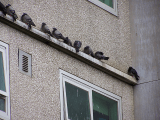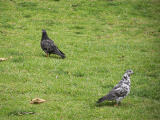Professional Pigeon control in Melbourne
Pigeon (Columbia livia)
Have a pigeon problem? We can help. Also known as rock doves, this species of bird excels in urban environments and can become a serious pest when populations soar. We offer a variety of effective pigeon control strategies in Melbourne to address infestations and keep your building protected.
Pigeon spikes, netting and a range of other methods
Anti-Bird Netting: This method is the most effective strategy for the complete exclusion of pigeons under any circumstances. HDPE Bird Netting is a highly adaptable protective measure that stops birds from reaching any part of the building’s architecture, making it perfect for structures with highly aesthetic exteriors.
The netting is made from High Density Polyethylene, a material that offers the highest UV resistance of any other form of netting. Additional UV stabilisers are added to the raw materials and will not be put at risk of water absorption or rotting.
We can also provide flame-proof netting that contains extremely fine filaments to give the netting fire retardant properties. These filaments melt and fall away before spreading any flames, ensuring the netting disintegrates instead of catching alight in the event of a fire.
Heavy-duty nylon zippers are installed when necessary to ensure access to smoke detectors, lights, sprinklers valves and other services isn’t hindered. We use only the highest quality materials, and our anti-bird netting can be designed to be virtually invisible. It’s a humane strategy that will eradicate any bird infestation for good.
Bird Shock Track: This method is highly effective in a range of situations, as the system sends a sporadic shock that the pigeons learn to keep away form in the long term. This innovation has begun to revolutionise the bird control industry to the point where many Melbourne building owners are paying to replace pigeon spikes with this system. It’s highly flexible and can installed on any architectural design and is virtually invisible form a distance, ensuring the aesthetic of the structure is unaffected.
Pigeon Spikes: A highly effective form of defence against pigeons in environments where the impact pressure is light to medium. Pigeon spikes are commonly used in Melbourne and are designed with stainless steel wires and UV-stabilised bases.
Bird Slope: An innovative proofing method that permanently keeps pigeons off window sills and ledges.
Post & Wire: Another effective strategy to stop pigeons from perching on piping, guttering and ledges.
Trapping: A common strategy to combat heavy pigeon infestation by reducing the feral population in the area.
Bird Control Agents: Specifically used for feral pigeon control in unique circumstances. Must be carried out precisely by a licensed professional.
Bristle Strips and Anti-Bird Mesh Systems: Where other control products and measures are not able to be used, bristle strips and anti-bird mesh systems are used to ward pigeons off from their preferred perching areas.
The highest standard of pigeon control
At Elite Bird Control, we are able to deliver effective solutions based on our in-depth understanding of various bird species.
Pigeons have completed adapted to living amongst humans in urban environments. As one of the most common birds in Melbourne, they have become a significant pest for both residential and commercial structures and often nest in locations protected from the elements and daily human activity. These locations include rafters in buildings, open roofs, signs, underside of bridges, air conditioners and more.
Identification: Roughly 33cm in length with feathers in a range of colours from black to white. The majority have a dark grey head with lustrous feathers, two dark bands on the wings and a light grey back. The body is usually stocky with a short neck, small head and short legs. The tail is black and squared off during flight.
Biology & Breeding: Pigeons construct loose nests out of leaves, stems, sticks and other materials. Because they are sometimes reused, nests often accumulate more debris and droppings and become solid. Breeding begins at six months of age—they usually lay two eggs, which are incubated for 16-18 days. Once hatched, the young feed on milk from the parent for several weeks; while they typically leave the next after five weeks, they still rely on the parent for feeding for another week or two. Once young have become independent, the parents start the breeding process again and can successfully breed as often as six times per year. This breeding cycle often results in soaring pigeon populations in areas where food is readily available.
Habits & damage: Pigeons nest in small groups and emerge to join a flock made of hundreds of other pigeons from nearby nesting areas. Unlike many other bird species, pigeons like to rest and feed flat, smooth and open surfaces; this allows them to find food and escape easily in the presence of danger. Feeding typically occurs within a few kilometres of nesting areas, and urban areas can suffer from extreme fouling without pigeon control measures in place. Diseases, droppings and nesting damage caused by pigeons are all common problems for urban areas in Melbourne.




